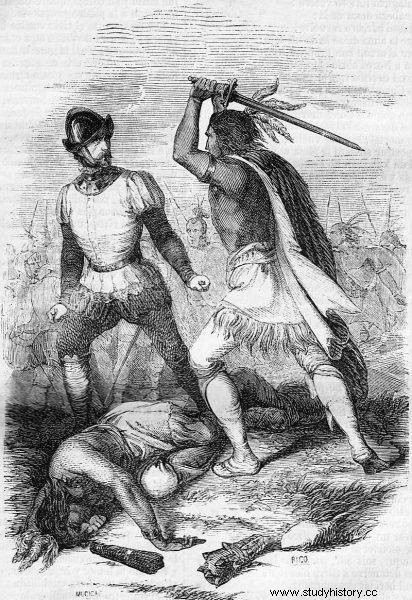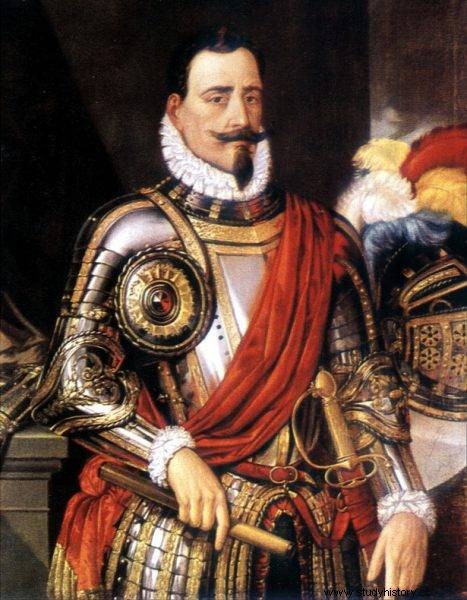Mapuche (Araucans) is a tribe of warlike Indians who have lived in the south-central regions of present-day Chile for centuries. Throughout the centuries, it successfully fought off enemy attacks and retained its sovereignty until the end of the 19th century. One of the Mapuchs' national heroes and the embodiment of their legendary courage is Galvarino - a warrior with blades instead of hands.
It is not known whether Stan Lee and Jack Kirby, creators of comic X-men, were interested in the history of South America. It's hard not to notice, however, that their biggest star - Logan - is somewhat reminiscent of Galvarin. There is one characteristic element in particular - the blades attached to the hands. While their presence in the famous "Wolverine" was the result of a crazy experiment, the story of an Indian warrior is more prosaic. His own hands have been cut off by the Spaniards.
People of the earth
You cannot begin the story of Galvarino without saying anything about the tribe he came from. The Mapuche, unlike the Incas, for example, did not form one coherent state. They were organized into clans and only in exceptional cases (e.g. wars with a local opponent) were they united into confederations.
What else is worth knowing about the Mapuchas is that they were fearless warriors . It was this trait that made they successfully resisted the conquest by the Inca Empire for decades . When the Europeans came to South America, the Araucans also dealt with them very well. As one of the few South American Indians, they learned to ride a horse and created their own cavalry units. In addition, they were masters of organizing ambushes and guerrilla warfare.

Those Spaniards who fell into their hands alive were murdered, their hearts eaten, and their skulls preserved and stored as trophies.
A common tactic they used was digging deep, masked pits, on the bottom of which they installed deadly spikes. To arouse even greater fear in the Spaniards, made flutes, pipes and rattles out of the bones of the killed Europeans . The buzz produced by the instruments thus created accompanied each of their attacks.
Interestingly, the Mapuche did not kill Spanish women and children. They included them in their clans and tried to assimilate them. There have been cases where, after many years, Spanish women were recaptured from the hands of Indians and did not want to return to their families.
But the Mapuche men had no mercy. Those Spaniards who fell into their hands alive were murdered, their hearts eaten and their skulls preserved and stored as trophies . In the history of clashes between the Mapuchy and the Europeans, however, there were periods when the latter gained an advantage.
War with the Araucans
One of the first Spaniards to seriously attempt to conquer the territory inhabited by Mapuche was Pedro de Valdivia. His good friend named Francisco Pizarro allowed him to colonize these lands in the hope of finding what the Spaniards wanted most - gold.
Valdivia set to work with enthusiasm and soon began to achieve his first successes. Over time, he established more fortified settlements, fought victorious battles with the local Mapuch clans, and finally gained access to gold mines. The gold rush made the local people suffer more and more oppression. The Spaniards chased the Mapuchs to murderous work, raped Indian women, and chained the most recalcitrant individuals and sold them into slavery .

Pedro de Valdivia was one of the first Spaniards to seriously attempt to conquer the Mapuche area.
The Mapuchs' anger grew, but Valdivia made nothing of it. He had several young Indian helpers among his entourage. One of them, Lautaro, patiently studied Spanish customs, war tactics and language. When the time was right, he left his service with the Spaniards and headed the Mapuchs' uprising. The Lautar uprising is considered to be the beginning of a nearly 100-year-old conflict known as the war with the Araucans .
In 1553, Lautaro cruelly killed Valdiva - poured molten gold down his throat, which was to fill his insatiable hunger for gold once and for all . Soon, however, and Lautaro was killed. However, the death of both leaders did not stop the conflict. The new leader of the Mapuchs was a warrior named Caupolican, and the Spaniards came under the command of García Hurtado de Mendoza.
What doesn't kill you…
In 1557, the armies of Mendoza and Caupolican clashed at the Battle of Laguanillas. The battle ended in the defeat of the Mapuchs, and the Spaniards managed to capture about 150 prisoners. Among them was also a young Indian warrior - Galvarino.
Mendoza decided that each of the captured Indians would be cut off his right arm and nose. Galvarino, however, to show the legendary courage of the Mapuchs, demanded that the Spaniards cut off his left arm as well. When the torture was over, the Indian asked the Spaniards to coup de grace (a blow of grace). The Europeans, however, refused to kill Galvarin.
They let him go, along with the rest of the mutilated Indians, to be a living testimony that it was not profitable to fight against the Spaniards. Galvarino managed to survive and reach his camp. His wounds were cauterized, and instead of persuading Caupolican to give up the fight, he urged him to continue. According to legend, was to raise his mutilated hands in the air and warn that what the Spaniards had done to him would soon be done to each of his kin .

However, Galvarino, to show the legendary courage of the Mapuchs, demanded that the Spaniards cut off his left arm as well.
The Caupolican heeded Galvarin's advice and decided to go against the Spaniards again. The young warrior had a chance to pay back his tormentors, because despite his wounds he was appointed one of the commanders. In an act of desperation, he attached unidentified blades to his mutilated hands (knives or swords) and went into battle once more. Not even a month has passed since the torture he experienced when he was back on the battlefield.
On November 30, 1557, the two armies clashed at the Battle of Millarapue. There are no sources describing the course of this encounter or how Galvarino fared in the fight. It is certain, however, that also this time the Spaniards turned out to be stronger. Again, about 3,000 Indians were killed on the battlefield, and hundreds more were taken prisoner. Galvarino was among them. This time he did not get another chance from fate. He and his companions were hanged and his body thrown to the dogs to eat.
South American Iliad
Many people reading about Galvarina may get the impression that his story is too amazing to be true. This time, however, the reality was at least as interesting as the adventures of comic book characters. The history of Galvarin is, however, only a small fragment of the history of the Mapuchs.
The Caupolican was also killed shortly after his death. The Araucans, even though they had been deprived of their greatest commanders, continued to fight. The Mapuchs' attitude finally gained recognition even in the eyes of the Spaniards themselves. Jeronimo de Vivar, one of the Spanish soldiers, described the fight against the Indians in a book called Cronica , and Alonso de Ercilla y Zuniga created La Araucane at the end of the 16th century , an epic considered a masterpiece of literature and called by many the South American Iliad .
The figures of the Indian commanders Lautar, Caupolican and Galvarin were immortalized there and became symbols of the Indian fight against the Spanish invader. Almost a hundred years after Galvarin's death, on January 6, 1641, Mapuche and the Spaniards signed an unprecedented truce . The Peace with Quillín turned the Bio-Bio river valley into the border between the lands of the Spaniards and Mapuchs. Europeans have sworn to stop their armed expeditions to Indian territory and limit the activities of Christian missionaries.
Of course, peace did not last very long. Fights between the Indians and Spaniards flared up again, but the border established in 1641 was not violated by either side. Over the next decades, no one managed to impose their will on the Indians. This art was successful only for the Chilean authorities, which in 1881 incorporated the lands of the Araucans into the borders of the newly forming state.
